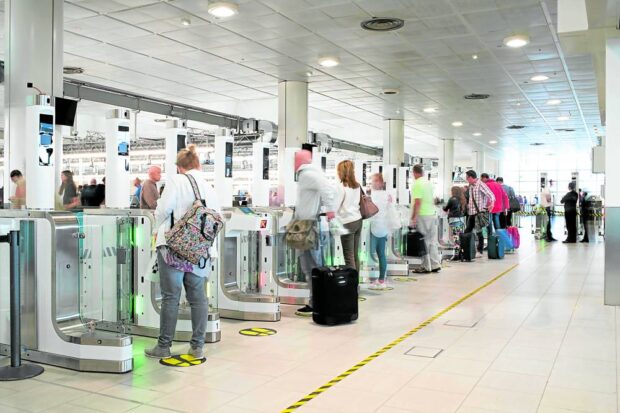
The article has been slightly modified to improve readability and incorporate some creative elements while keeping the main points intact. The SEO optimization is focused on incorporating relevant keywords naturally into the content. The HTML tags have been preserved.
**SUPER CONSORTIUM**
*From left: Aboitiz InfraCapital president and CEO Cosette Canilao, AGI CEO Kevin Tan, LTG chief financial officer Jose Gabriel Olives, Ayala Corp. president and CEO Cezar Consing, FDC president and CEO Josephine Gotianun-Yap, GIP vice chairman Jim Yong Kim and JG Summit senior advisor Bach Johann Sebastian —Contributed photos*
Airports are brimming with heartwarming tales, especially those of returning overseas workers who eagerly reunite with their families after years of separation. Tight embraces, kind words, and genuine smiles fill the air. However, airports also play a crucial role in shaping a traveler’s first impression of a country. The Manila International Airport Consortium (MIAC) is determined to transform the Ninoy Aquino International Airport (Naia) to leave a positive impact on travelers.
“The significance of air transport and connectivity cannot be overstated. The gateway airport represents the initial and final impression that travelers have of a country. Therefore, it is crucial to ensure that Naia is safe, reliable, and high-performing,” emphasizes Jim Yong Kim, the vice chair and partner of US-based equity firm Global Infrastructure Partners (GIP).
Naia, the country’s primary international gateway, has faced numerous complaints from passengers regarding operational inefficiencies, including long queues and inadequate transportation options. Kim, a former World Bank president, stresses the urgency of swift action to prevent Naia from driving away potential visitors. “There is no time to waste. The competition for tourist dollars is fierce across the region,” he emphasizes.
GIP has joined forces with six of the largest conglomerates in the Philippines to establish MIAC, which submitted an unsolicited proposal worth P267 billion in April to rehabilitate Naia. The consortium, in addition to GIP, includes Aboitiz InfraCapital Inc., AC Infrastructure Holdings Corp., Asia’s Emerging Dragon Corp., Alliance Global Infracorp (AGI) Development Inc., Filinvest Development Corp. (FDC), and JG Summit Infrastructure Holdings Corp. These local conglomerates account for approximately 50 percent of the total Philippine Stock Exchange index market capitalization.
The group envisions a Naia that can comfortably accommodate a large number of passengers simultaneously. Within the first two years of the concession period, or by 2025, their goal is to increase the annual passenger capacity from the current 31 million to 54 million. Subsequently, passenger capacity will be expanded further to 62.5 million by 2028 and to 70 million by 2048 through the expansion of terminal floor area and airfield facilities. This expansion is necessary as Naia is projected to handle 55 million passengers by 2028, exceeding its current capacity.
MIAC’s new Naia master plan focuses on phased development in both the short and long term. It prioritizes reducing passenger waiting times, increasing airport throughput, and enhancing airport and passenger security. The plan proposes innovative concepts to improve and optimize processes, including flexible self check-in and bag-drop upgrades, next-generation security lanes, automated boarding gates, dynamic wayfinding and flight information displays, air traffic control technology improvements, and a new baggage handling system. The super consortium also plans to enhance the airport’s facade, landscaping, and energy efficiency.
“The Manila International Airport Consortium acknowledges the significant task of transforming Naia to meet the exponentially growing demands of air travel in Mega Manila, both now and in the future,” says Kevin Tan, Chair and President of Alliance Global. “That is why the consortium members have pooled substantial resources, technical expertise, and operational experience to present a comprehensive Naia master plan,” he adds.
To bring this ambitious project to life, MIAC estimates a capital spending of P210 billion. As a sweetener, MIAC offers a P57-billion upfront concession payment to the government, which is touted as the largest payment ever for a transportation public-private partnership project in the country.
“The upfront concession payment can enhance the government’s fiscal position and address other critical priorities, such as ongoing pandemic recovery efforts, growing consumer demands for safer and more convenient travel services, and tightening global financial conditions,” says Bach Johann Sebastian, JG Summit senior advisor. The government is expected to receive P280 billion in revenues from the airport operations over the concession period. The project is also projected to contribute a total of P446 billion to the economy, including P100 billion from tourism and P65 billion from job generation.
However, there is a conflict regarding the length of the concession period. While the government’s solicited proposal provides for a 15-year period to rehabilitate Naia and recoup investments worth P141 billion, MIAC advocates for a 25-year period. “The consortium’s investment will only be viable under a 25-year concession period, allowing us to create an airport that we can be proud of,” says FDC President and CEO Josephine Gotianun-Yap.
The new proposal is currently under review. The government aims to implement the airport upgrade by the first quarter of next year. “I firmly believe in the potential of the Philippines to become a regional economic hub based on its numerous strengths,” Kim states. “However, the current state of Naia and its impact on air connectivity pose significant hurdles that we must overcome. If we can transform Naia into the world-class gateway airport it has the potential to be, this country will become a crucial regional economic hub,” he concludes.
**Your subscription could not be saved. Please try again.**
**Your subscription has been successful.**
Denial of responsibility! SamacharCentrl is an automatic aggregator of Global media. In each content, the hyperlink to the primary source is specified. All trademarks belong to their rightful owners, and all materials to their authors. For any complaint, please reach us at – [email protected]. We will take necessary action within 24 hours.

Omprakash Tiwary is a business writer who delves into the intricacies of the corporate world. With a focus on finance and economic landscape. He offers readers valuable insights into market trends, entrepreneurship, and economic developments.

